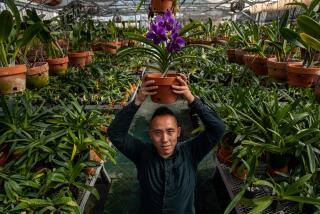IDEAS /SAVING A HERITAGE : Group Promotes Plant Diversity : Rare seeds are tracked down and grown on Iowa farm to preserve genetic variety.
- Share via
DECORAH, Iowa — You can’t miss the Moon and Stars watermelon growing next to the big red barn at the Seed Savers Exchange farm, even through the mist of a gray autumn afternoon.
Kent Whealy, founder and director of the nonprofit seed exchange, had searched for years for the rare fruit with bright yellow spots on a dark-green rind.
In 1981, a Missouri man heard Whealy describe the melon on a local television program and realized he was growing it in his own garden.
Whealy’s search for the strange fruit is part of his mission to preserve genetic diversity in fruits and vegetables, which is in danger of being lost forever.
His work has not gone unnoticed. In July, he received a phone call telling him that he had won a MacArthur Fellowship through the John D. and Catherine T. MacArthur Foundation. That $275,000 award, one of 36 granted this year, is intended to set him free for five years to pursue personal work.
“What we’re seeing today in this country is that the vast majority of plant materials available to gardeners is on the verge of becoming extinct,” said Whealy, 44, a soft-spoken, large-framed man comfortable in blue jeans and flannel shirts.
One endangered type is the heirloom seed brought over from the old country; another comprises regional varieties that are gradually being squeezed out of seed catalogues through consolidations in the industry.
“What we’re really talking about is that the breeding material for the crops of the future is dying out,” he said.
Until the 1920s or 1930s, most seeds were gathered locally for special traits of size, color, vigor or even for sentimental reasons. But varieties began dying out when gardeners quit saving seeds in favor of buying commercial seeds.
Today, many seed catalogues offer hybrid varieties that are the same as, or similar to, those developed for commercial growers, Whealy said. They are thick skinned, ripen uniformly and travel well across thousands of miles to the nation’s supermarkets. But that genetic uniformity can be boring and makes some crops especially vulnerable to disease and pests.
As members of the Seed Savers, about 800 gardeners around the country offer more than 5,000 distinct back-yard-grown varieties for the cost of postage through an annual yearbook to about 5,000 subscribers. Members also describe seeds they are looking for. Heirloom and back-yard garden seeds tie today’s gardeners to their past and are important pieces of cultural history, Whealy said. Each carries a story.
Aunt Mary’s sweet corn was bred in the 1930s in Ohio. “It’s so sweet that it’s hard to dry the corn on the plant; it molds, there’s so much sugar in it,” Whealy said.
Big Rainbow is a fat yellow beefsteak tomato with red rays spreading out from the blossom scar. “When you cut the tomato, the flesh is marbled with red and yellow--it’s a wonderful thing; it’s luscious.”
Seeds for the heirloom German pink tomato, tender Snipple pole bean and a bright purple morning glory were brought to America in the 1860s by Bavarian ancestors of Whealy’s wife, Diane.
Diane Whealy’s grandfather, named Baptist John Ott, handed down three jars of the family seeds to the Whealys nearly 20 years ago. That gift spawned the Whealys’ obsession with old seeds and their creation of the Seed Savers Exchange in 1975.
Today, Whealy admits, he spends little time in the garden. “It’s kind of odd, because that’s what I love doing the most,” he said. He mostly sits at a personal computer, writing Seed Savers publications and filling out grant applications.
He and a small staff run the exchange on a roughly $300,000 budget. Their office is in a bungalow near downtown. Just outside town is the 140-acre Heritage Farm, nestled in hills dotted with limestone bluffs.
The farmhouse there is home to the Whealys and their children. On the grounds, employees maintain a 6,000-variety collection, including 2,200 distinct beans, 1,600 tomatoes, 500 peppers and 350 lettuces, among others.






